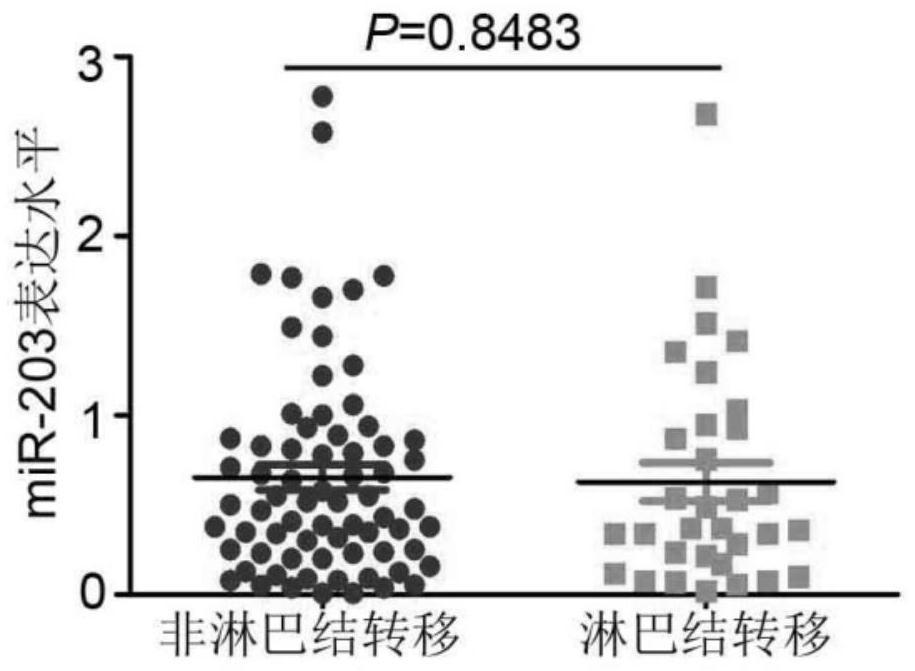Application of microRNA molecule in diagnosis and treatment of lymph node metastasis of T1-stage esophageal squamous cell carcinoma
A technology for lymph node metastasis and esophageal squamous cell carcinoma, applied in the direction of DNA/RNA fragments, medical preparations containing active ingredients, recombinant DNA technology, etc., can solve the problem of difficult treatment plans, excessive radiotherapy, chemotherapy, and inadequate treatment of patients with lymph node metastasis And other issues
- Summary
- Abstract
- Description
- Claims
- Application Information
AI Technical Summary
Problems solved by technology
Method used
Image
Examples
Embodiment 1
[0070] Embodiment 1: the method for detecting the expression of microRNA-20b gene in paraffin tissue
[0071] 1. Extract paraffin tissue RNA with Qiagen kit
[0072] (1) Sample source
[0073] The tissue samples of T1 esophageal squamous cell carcinoma were obtained from the Cancer Hospital of the Chinese Academy of Medical Sciences. There were enough formalin paraffin-embedded tissues to obtain sufficient microRNA, and there were complete medical written records and follow-up records. They were divided into two groups for microRNA microarray detection to screen microRNAs associated with lymph node metastasis of T1 esophageal squamous cell carcinoma. Another independent formalin-fixed paraffin-embedded tissue of T1 esophageal squamous cell carcinoma was selected to verify the microarray results. RNeasy FFPE Kit (Qiagen, 74404) was used, and the extraction steps were carried out according to the instructions attached to the kit.
[0074] 2. Total RNA quality detection
[00...
Embodiment 2
[0099] Embodiment 2: the method for detecting the expression of microRNA-20b gene in serum
[0100] 1. In vitro transcription and synthesis of mouse non-coding RNA-GM13008
[0101] MEGAscript T7 Transcription Kit (AM1334, Invitrogen) was used, and the in vitro transcription step was performed according to the instructions attached to the kit.
[0102] 2. Extract serum RNA with Qiagen kit
[0103] Serum samples of T1 esophageal squamous cell carcinoma were obtained from the Cancer Hospital of the Chinese Academy of Medical Sciences. There was enough serum to obtain sufficient microRNA, and there were complete medical written records and follow-up records. After mixing 100 ng of mouse-derived non-coding RNA-GM13008 per 100 ul of serum, serum RNA was extracted with QIAamp Circulating Nucleic Acid Kit (Qiagen, 55114), and the extraction steps were performed according to the instructions attached to the kit.
[0104] 3. Total RNA quality detection
[0105] (1) NanoDrop (Gene Com...
Embodiment 3
[0124] Example 3: Study on the biological effects of treating the cell supernatant produced by esophageal cancer cells with microRNA-20b inhibitors to inhibit the tube-forming and migration abilities of human lymphatic endothelial cells
[0125] 1. Experimental steps
[0126] (1) Cell culture
[0127] Human esophageal cancer cell lines: KYSE30 and KYSE450 (gifted by Professor Shimada Y of Kyoto University), RPMI1640 medium (Gibco), containing 10% fetal bovine serum (FBS, Gibco), cultured at 37°C, 5% CO2.
[0128] Human lymphatic endothelial cell line: HDLEC (Shanghai Guyan Biotechnology Co., Ltd.), RPMI1640 medium (Gibco), containing 10% fetal bovine serum (FBS, Gibco), cultured at 37°C, 5% CO2.
[0129] (2) Transient cell transfection
[0130] a. microRNA-20b inhibitor transient transfection
[0131] The sequence of the microRNA-20b inhibitor: 5'CUACCUGCACUAUGAGCACUUUG 3' (SEQ ID NO: 5), synthesized by Invitrogen.
[0132] (1) Preparation of microRNA-20b inhibitor: Add 10...
PUM
 Login to view more
Login to view more Abstract
Description
Claims
Application Information
 Login to view more
Login to view more - R&D Engineer
- R&D Manager
- IP Professional
- Industry Leading Data Capabilities
- Powerful AI technology
- Patent DNA Extraction
Browse by: Latest US Patents, China's latest patents, Technical Efficacy Thesaurus, Application Domain, Technology Topic.
© 2024 PatSnap. All rights reserved.Legal|Privacy policy|Modern Slavery Act Transparency Statement|Sitemap



